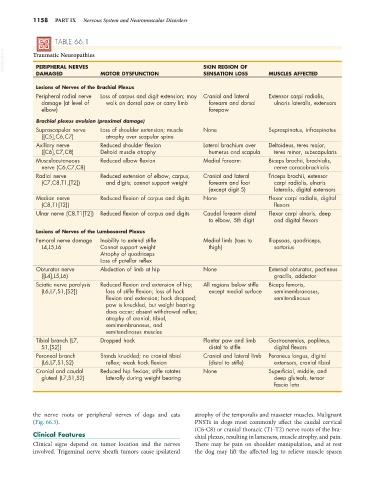Page 1186 - Small Animal Internal Medicine, 6th Edition
P. 1186
1158 PART IX Nervous System and Neuromuscular Disorders
TABLE 66.1
VetBooks.ir Traumatic Neuropathies SKIN REGION OF
PERIPHERAL NERVES
DAMAGED MOTOR DYSFUNCTION SENSATION LOSS MUSCLES AFFECTED
Lesions of Nerves of the Brachial Plexus
Peripheral radial nerve Loss of carpus and digit extension; may Cranial and lateral Extensor carpi radialis,
damage (at level of walk on dorsal paw or carry limb forearm and dorsal ulnaris lateralis, extensors
elbow) forepaw
Brachial plexus avulsion (proximal damage)
Suprascapular nerve Loss of shoulder extension; muscle None Supraspinatus, infraspinatus
([C5],C6,C7) atrophy over scapular spine
Axillary nerve Reduced shoulder flexion Lateral brachium over Deltoideus, teres major,
([C6],C7,C8) Deltoid muscle atrophy humerus and scapula teres minor, subscapularis
Musculocutaneous Reduced elbow flexion Medial forearm Biceps brachii, brachialis,
nerve (C6,C7,C8) nerve coracobrachialis
Radial nerve Reduced extension of elbow, carpus, Cranial and lateral Triceps brachii, extensor
(C7,C8,T1,[T2]) and digits; cannot support weight forearm and foot carpi radialis, ulnaris
(except digit 5) lateralis, digital extensors
Median nerve Reduced flexion of carpus and digits None Flexor carpi radialis, digital
(C8,T1[T2]) flexors
Ulnar nerve (C8,T1[T2]) Reduced flexion of carpus and digits Caudal forearm distal Flexor carpi ulnaris, deep
to elbow, 5th digit and digital flexors
Lesions of Nerves of the Lumbosacral Plexus
Femoral nerve damage Inability to extend stifle Medial limb (toes to Iliopsoas, quadriceps,
L4,L5,L6 Cannot support weight thigh) sartorius
Atrophy of quadriceps
Loss of patellar reflex
Obturator nerve Abduction of limb at hip None External obturator, pectineus
([L4],L5,L6) gracilis, adductor
Sciatic nerve paralysis Reduced flexion and extension of hip; All regions below stifle Biceps femoris,
(L6,L7,S1,[S2]) loss of stifle flexion; loss of hock except medial surface semimembranosus,
flexion and extension; hock dropped; semitendinosus
paw is knuckled, but weight bearing
does occur; absent withdrawal reflex;
atrophy of cranial, tibial,
semimembranosus, and
semitendinosus muscles
Tibial branch (L7, Dropped hock Plantar paw and limb Gastrocnemius, popliteus,
S1,[S2]) distal to stifle digital flexors
Peroneal branch Stands knuckled; no cranial tibial Cranial and lateral limb Peroneus longus, digital
(L6,L7,S1,S2) reflex; weak hock flexion (distal to stifle) extensors, cranial tibial
Cranial and caudal Reduced hip flexion; stifle rotates None Superficial, middle, and
gluteal (L7,S1,S2) laterally during weight bearing deep gluteals, tensor
fascia lata
the nerve roots or peripheral nerves of dogs and cats atrophy of the temporalis and masseter muscles. Malignant
(Fig. 66.3). PNSTs in dogs most commonly affect the caudal cervical
(C6-C8) or cranial thoracic (T1-T2) nerve roots of the bra-
Clinical Features chial plexus, resulting in lameness, muscle atrophy, and pain.
Clinical signs depend on tumor location and the nerves There may be pain on shoulder manipulation, and at rest
involved. Trigeminal nerve sheath tumors cause ipsilateral the dog may lift the affected leg to relieve muscle spasm

